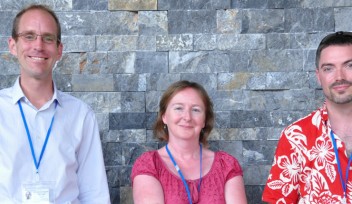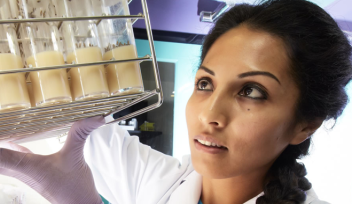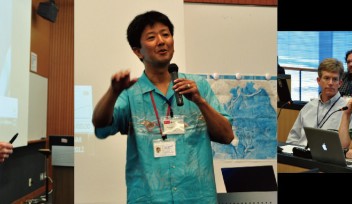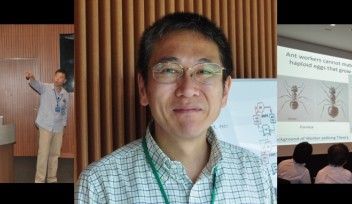The Frontiers of Quantitative Genome Research
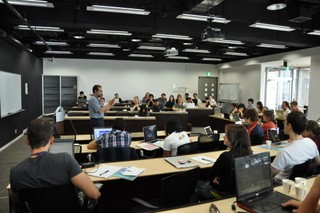
By Kaoru Natori
Young scientists from sixteen countries have gathered at OIST to participate in the Summer School and Workshop “Quantitative Evolutionary and Comparative Genomics (QECG).” During three weeks of intensive lectures and tutorials taught by seventeen lecturers and six tutors from Japan and overseas, thirty graduate students and post-graduate researchers with background in biology and computation are learning the latest advances in the application of statistics, computation and experiment to the genomes of populations. The participants will return to their labs with new knowledge and practical skills for their research.
Dr. Jonathan Miller, Principal Investigator of the Physics and Biology Unit and one of the organizers of the course, said, “The course introduces students to the frontiers of quantitative genomic research that incorporate statistics, physics, mathematics, computation and experiment.” He added, “The topic of one lecture was how human genome data are used to study population movement over the course of history. Other lectures addressed quantitative and physical approaches to the study of how bacteria exchange genetic material.”
Genomics is a discipline of genetics involving the study of the fundamental elements of an organism's hereditary information. Since the genome the small roundworm C. elegans was first decoded by OIST President Dr. Sydney Brenner and others in 1998, more than forty animal genomes have been sequenced and published. They include fruit fly, human, pufferfish (fugu), mouse and rat. The application of computational analysis to decipher biology of genome sequences has become increasingly important now that these whole-genome sequences have become publicly available.
In one of the lectures cited by Dr. Miller, Dr. Simon Myers of Oxford University discussed how his group had used human genome information to infer underlying population structure around the globe. Over the course of history, people have moved from one place to another, mixing populations to yield blends of people of different origin. In order to measure this blending, Dr. Myers’ group constructed what he referred to as a “recombination map” of almost 30,000 unrelated African Americans. His group discovered and isolated more than 3,000 ‘recombination hotspots’ in the human genome that are active in people of West African ancestry but are nearly inactive in Europeans. It turns out that these hotspots are recognized by a protein composed of nine “zinc fingers,” DNA-binding structures first identified over twenty-five years ago by Dr. Miller. This is an example of how computational genomics can provide new insight into population studies.
Asked about his impression of the course, Dr. Oleg Gusev, a Russian researcher currently working for the National Institute of Agrobiolologcal Sciences in Japan, said, “This is the third time for me to participate in a course at OIST. Schools and courses at OIST are great. They are uniquely designed to bring together experimenters and theoreticians. The courses usually last for a few weeks, and this enables participants to study a field in great depth. Instead of passively listening to lectures, we get the opportunity to engage in discussion with world-leading scientists in the field. We also get to present our own research in a poster session, which stimulates further discussions.”
Mr. Akihiro Takahashi, a student at the School of Life Science, the Graduate University for Advanced Studies in Kanagawa Prefecture, Japan, , who is conducting research at National Institute of Genetics in Mishima, Shizuoka Prefecture, said, “I am an experimental biologist working on budding yeast. In order to broaden my knowledge in bioinformatics, I applied for this course. I am enjoying the program and networking with other participants.”
Ms. Anjali Gupta Hinch, a Ph.D. student at Wellcome Trust Centre for Human Genetics, Oxford University, commented, “I use mathematical methods to understand fundamental questions in biology. I feel very fortunate to have had the opportunity to listen to experts from different fields and meet with fellow students of various backgrounds. My roommate during my stay at OIST is a bioinformatics student from China, who conducts plant genome research at a botanical garden.”
QECG has been organized by Dr. Jonathan Miller and Dr. Alexander Mikheyev of OIST, together with Dr. Gilean McVean of Oxford University. For details, visit our Website.
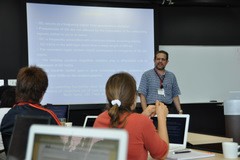
|
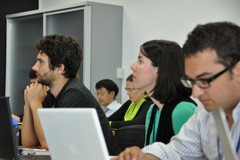
|










